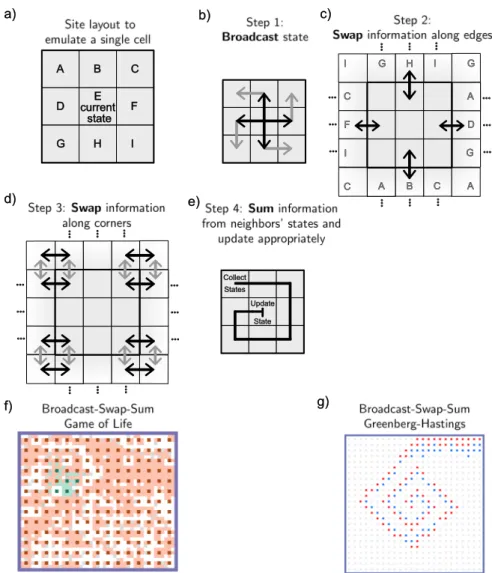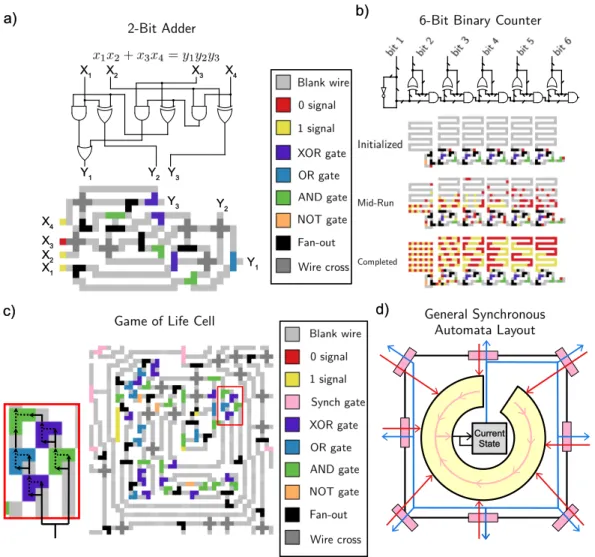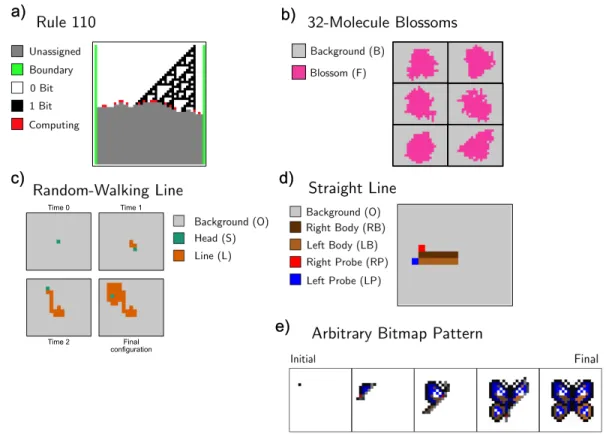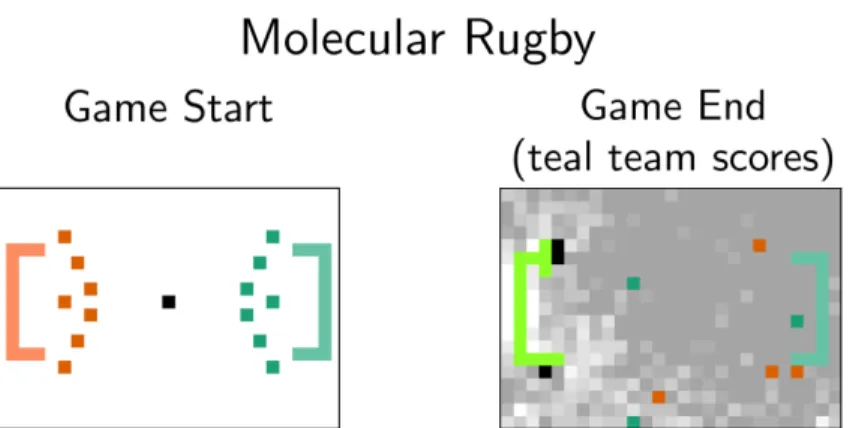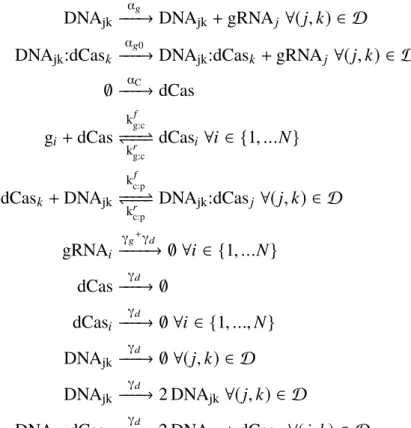Introduction
Programming and Simulating Chemical Reaction Networks on a
Introduction
Stochastic CRNs can also calculate anything, although most of the time the calculation is only correct – occasionally it is wrong (Cook et al., 2009; Soloveichik, Cook, et al., 2008). Other, more complex surface chemical reactions can produce Sierpiński triangles (Shang et al., 2015; N.
Review: What is a Surface CRN?
The surface CRN model is defined for arbitrary graphs of terrain, but for simplicity we will only consider square lattice grids in this paper (although our simulator can handle arbitrary graphs). Note that the surface CRN is a discrete, stochastic model related to stochastic reaction-diffusion systems (Hattne, Fange, & Elf, 2005; Fange et al., 2010) but with several key differences.
Dynamic Spatial Patterns
You may want to repeat these exercises for the other surface CRN implementations of the GH machine given in later sections. Consequently, the rate of each chemical reaction can only influence the timing of CRN surface evolution, and not the final results.
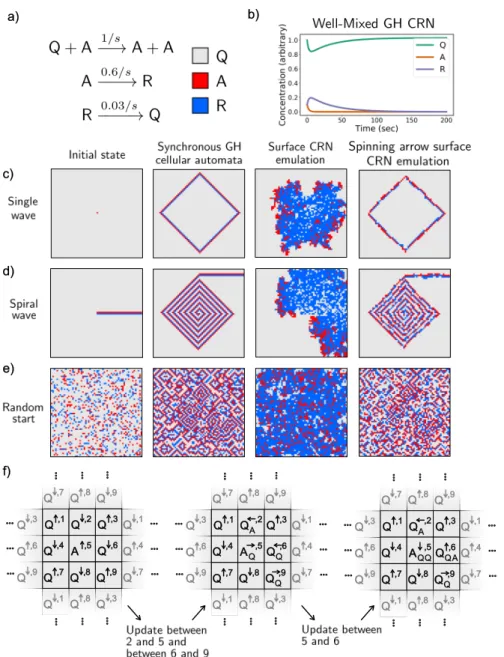
Continuously Active Logic Circuits
A two-input logic gate can be built with an architecture similar to that of the NOT gate. At first glance, this implementation of Game of Life seems cumbersome compared to the much more compact emulation method described in section 2.3.
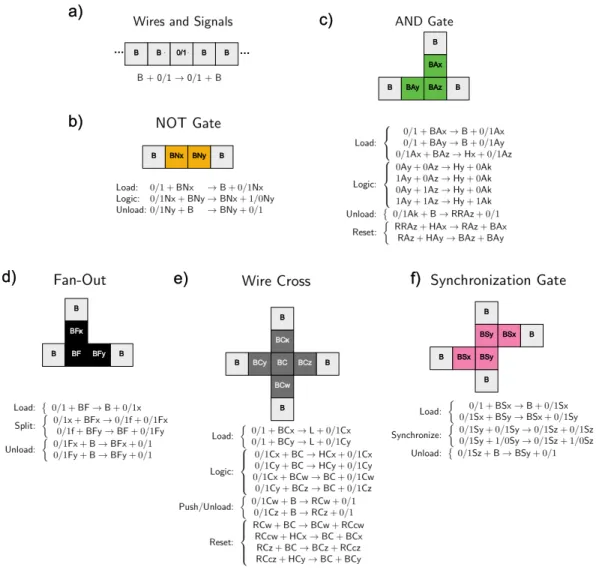
Manufacturing
With two more lines we can double the area of the blossom; in general, the number of lines required scales with the log of the size of the flower. Can you do it so that the number of lines required scales less than linearly with the length of the line. This algorithm requires a fairly large number of responses, which scales linearly with the number of painted pixels.
Robots and Swarms
This algorithm is very similar to the anthill building algorithm at the beginning of this section. The primary difference between the two is that the cargo sorting robot distinguishes between a cargo and its target and can mark lost cargo as belonging to the target. N goals more than the other, it is declared the victor; otherwise, the team with fewer reaction rules wins.
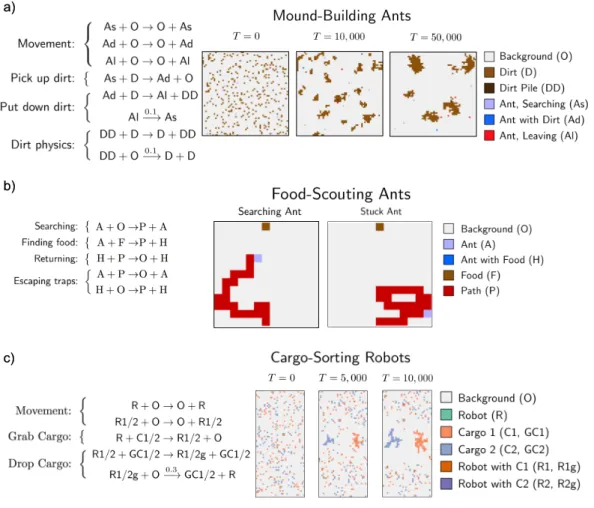
Conclusions
Also note that the existence of multiple limit cycles in the CRISPRlator implies that linearization characterization of the steady state of. Leak is given in units of the rate of gRNA production from an unbound promoter. Targets can be other gRNAs, as in the 5-node CRISPRi oscillator (CRISPRlator) (b). c) Deterministic and stochastic (SSA, non-linear) simulation of the 5-node CRISPRlator.
Modeling Dynamic Transcriptional CRISPRi Circuits
Introduction
Binding of dCas can interfere with prokaryotic transcription, either preventing initiation of transcription (if the gRNA is targeted within or immediately around a promoter) or blocking elongation (if the gRNA is targeted downstream of a promoter) (Qi et al., 2013). Low-cost CRISPRI endpoint logic gates have been designed at least twice (A. A. Nielsen and C. A. Voigt, 2014; Gander et al., 2017), and circuits up to eight gates deep and using up to a dozen gates in total have been built (although signal degradation over multiple layers was a consistent problem). CRISPRi has also been used to make circuits with simple dynamic behavior (Santos-Moreno, Taisiudi, et al., 2020; Kuo et al., 2020), but has not yet been widely adapted to create scalable prokaryotic circuits.
A Model of CRISPRi
In bacterial cells, the rate of dCas unbinding from DNA is significantly slower than bacterial replication rate, even in non-lab-adapted strains with division times exceeding 100 min (Jones et al., 2017) (though possibly not (Gong et al., 2017)). For example, (Gong et al., 2017) report an unbinding rate of dCas from DNA of about 1/(6.5 min) in a radiolabeled pulse chase assay, but this is inconsistent with the observation of (Jones et al., 2017 ) that dCas dissociation in vivo is driven by cell division or with real-time measurements of single molecules from (Boyle et al., 2017), who could not observe sufficient unbinding events over several hours to estimate an unbinding rate for matched gRNAs (setting an upper limit for unbinding time in the order of hours). The parameters for dCas:DNA interactions chosen in Table 3.1 use binding rates from Mekler et al., and reflect the canonical understanding in the field that dCas for all practical purposes does not bind to DNA.
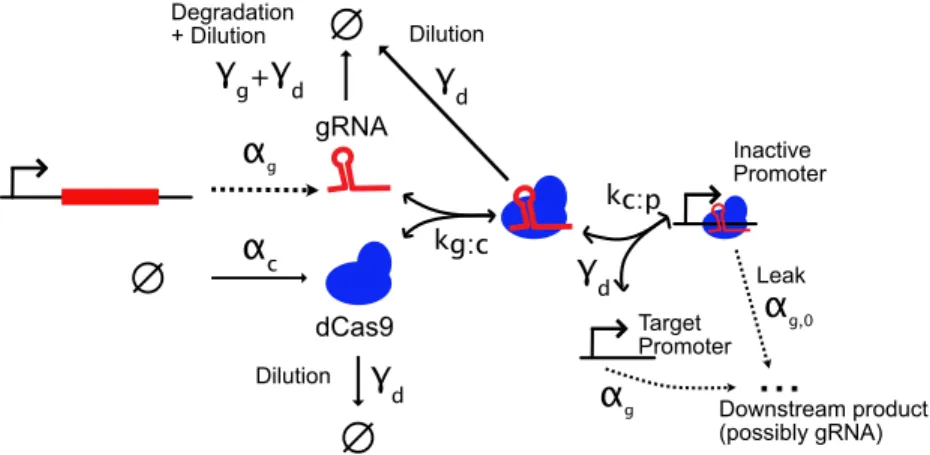
Modeling Results
The authors show that a simple model similar to our full model fails to predict the steady-state instability required for bistability in the switch (Figure 3.4, left). We can produce a similar "spec sheet" for dCas degradation and leakage for a 5-node CRISPRi repressilator, as shown in Figure 3.7B. On the other hand, the parameter requirements for the toggle switch appear to be quite similar to those for the 3-node repressilator (Figure 3.7C).
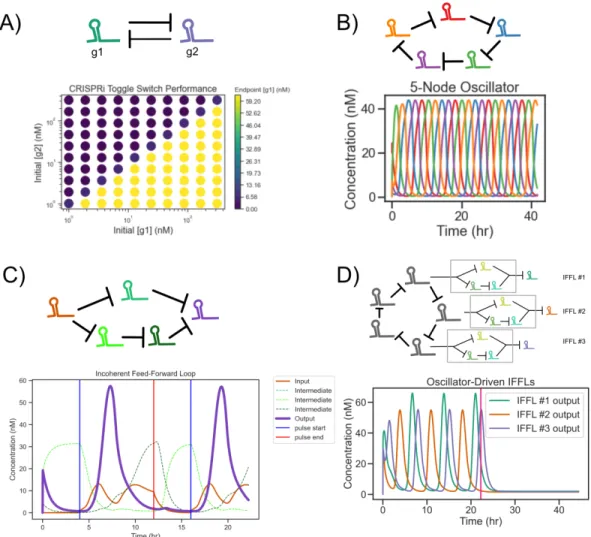
CRISPR Activators Scale Better Than CRISPR Inhibitors
See Section 3.2 for a description of the model and details of how we calculate fold change. We wish to calculate the fold change of target suppression of g1 as a function of N. A) B). Surprisingly, excess fold-change performance is more sensitive torA, fold-change activation for promoters bound to a CRISPR activator.
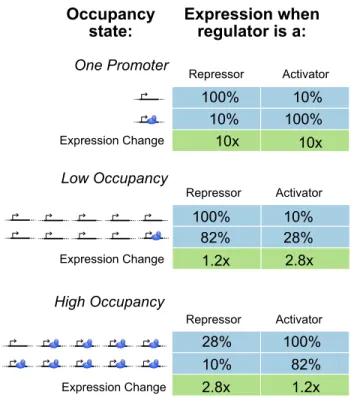
Engineering Requirements of CRISPRi
Any off-target PAM present in the cell slows down the rate of proper binding by acting as a low-affinity "decoy" binding site, which slows binding to the target promoter. There are good reasons to use CRISPRi instead of CRISPRa in the construction of bacterial biospheres, at least for the foreseeable future. CRISPRi efficiency is predicted to drop precipitously for systems above about a dozen gRNAs, while CRISPRa is expected to still work in the presence of tens to hundreds of competing gRNAs.
Conclusions
The critical property of the dummy-triggered replication mechanism is its ability to achieve the (biologically important!) property of having a defined, stable steady state. Surprisingly, we have discovered that the concentration of DN Apis is roughly constant regardless of the copy number of the plasmid. Finally, we can simulate the effect of decreasing the copy number of the plasmids carrying the CRISPRlator.
How to Model Replicating DNA (and Why)
Introduction
Although most synthetic biocircuits use DNA, models of synthetic biocircuits usually do not explicitly describe the dynamics of these types of DNA. For example, some circuits use DNA in different states as a dynamic component or readout (for example integrase-based state machines (Roquet et al., 2016)). Explicit representation of DNA can also be useful when DNA binding is slow relative to other circuit processes (for example, CRISPR-based transcription factor networks under some conditions (Jones et al., 2017)).
Trivially-Replicating Plasmids Have No Well-Defined Copy Number 81
In other words, the only finite, nonzero stable state of the trivial replication mechanism occurs when production is precisely balanced by dilution, and such a stable state is structurally unstable. The trivial replication mechanism is unstable because it makes both the production and degradation of DNA linearly dependent on the concentration of the DNA itself. Dummy-triggered replication leads to a stable steady-state concentration of DNA, as shown in Figure 4.1B.
Biological Models of Plasmid Replication Approximately Reduce to
This means that the per-plasmid rate of ColE1 replication decreases as the concentration of ColE1 plasmids increases, which gives ColE1 a finite steady state. The dynamics of the creation and destruction of R must be fast (ie, R must be in a quasi-steady state compared to DNA and DN Ap. Because cr ep is, by assumption, relatively slow, we can also consider the quasi-steady state concentration of DN Ap.
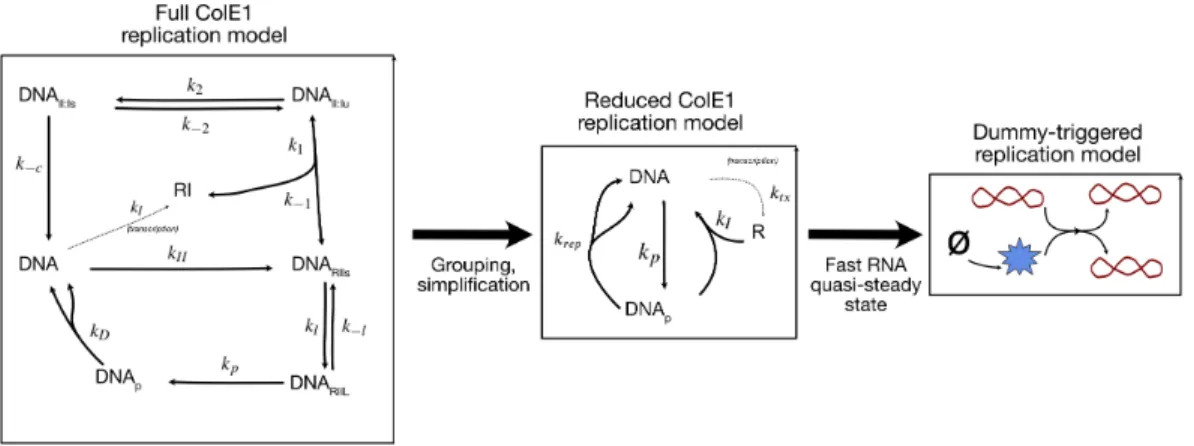
Worked Examples
Each point is the concentration of total RNA for one of the five gRNAs in one cell at a time. The final distribution of cell states can be used as a readout of the time delay between the presentation of A and the entry of B. C) Representative simulation of a genomically integrated time logic gate (ie, without explicitly replicating the DNA species of). A straightforward way to ask whether a one-cell transient logic gate can still give analog measurements is to simulate it.
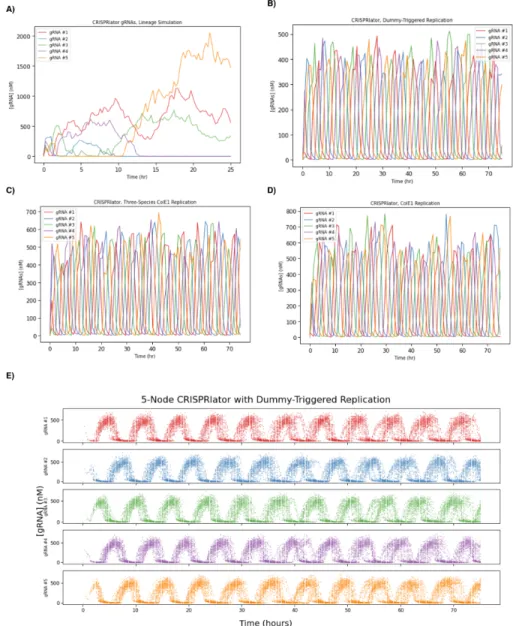
Discussion
When we add plasmid replication to the temporal logic gate, we see that it still works on a replicating plasmid, albeit with more noise than the original genome-located temporal logic gate (Figure 4.8)—but this version only requires a single cell where the original was designed to function in a population of thousands to millions of cells. The temporal logic gate on a replicating plasmid. a) Total number of copy number 30 or 100 plasmids in each condition across a population of 1,056 cells introduced into A at 2 hours and B at 10 hours. b) Same data as in (a), divided into individual cell copy number of plasmids in each condition. The dummy-triggered replication model is unable to replicate these empirical distributions—the model has only one (non-dimensionalized) degree of freedom in its parameters, and when this parameter is set so that our model's mean matches any empirically observed mean, the model predicts a distribution with much lower variance than the empirically measured distribution.
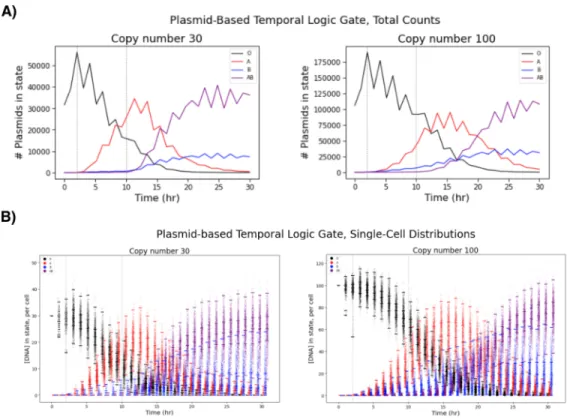
Conclusions and Future Work
Programming and Simulating Chemical Reaction Networks on a Sur-
We have shown that synchronous cellular automata can be constructed with a surface CRN; what such automata would be most useful to build. We have shown that surface CRNs are capable of simple swarm robot behaviors; how much behavioral complexity can be efficiently packed into a surface CRN. We may not currently have a fully programmable surface CRN board, but the technology needed to build one likely already exists.
Modeling Dynamic Transcriptional Circuits with CRISPRi
We have shown that surface CRNs are capable of both primitive and sophisticated pattern generation; how to efficiently increase the volume and complexity of surface production of CRN. We strongly believe that perhaps the most important and revelatory applications of surface CRN are yet to be envisioned, and hope that this work will serve as a gateway to the much broader field of molecular design. In addition, the dCas9 CRISPRlator from (Kuo et al., 2020) was shown to be significantly inferior to a similar CRISPRlator constructed from a deactivated version of Cas12a.
How to Model Replicating DNA (and why)
Elucidating the causes of these differences would help make existing CRISPRi models more useful design tools. It may turn out that future CRISPRi work will be done with Cas12a, another Cas family protein, or another CRISPR component entirely; in either case, we would do well to expand our CRISPR models.
